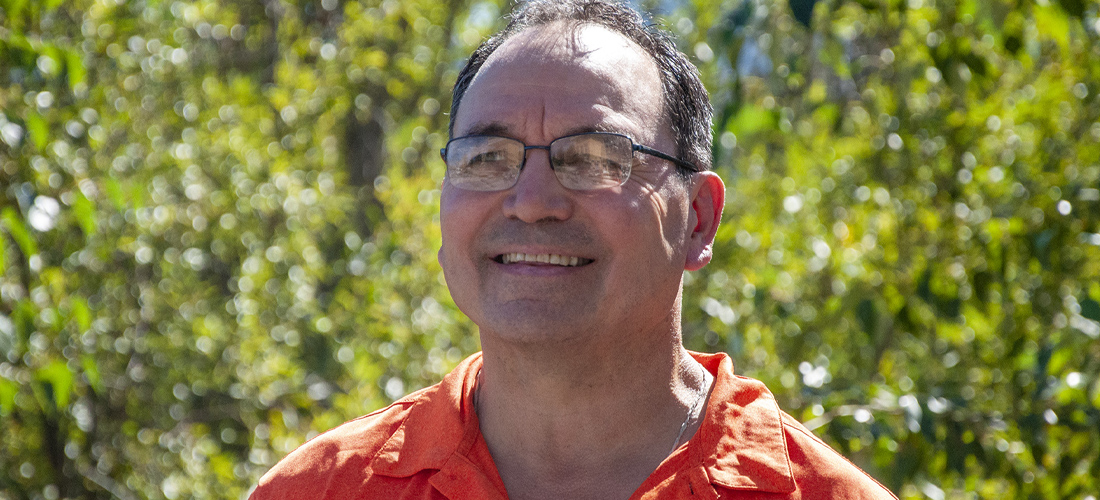
An educator, artist, story-teller, author and the newest Okanagan School of Education faculty member – Bill Cohen.
Since he was a young child, Cohen was often asked to draw various things for community members, like team logos or cartoons for little kids. His skill set has expanded over the years to include painting and carving. He draws his inspiration from the natural world around him and family and community stories.
He has also illustrated a number of books over the years, and recently illustrated a new book written by Harron Hall, from the Syilx & Nla’kapamuc Nations.
Question and Answer Session with Bill Cohen
How has your passion for art developed over the years?
I’ve always enjoyed being creative – whether that was drawing or carving. I would say that I have been a community artist since I was a teenager.
In our community, our grave markers are made from pitch pine tops, and names, dates and imagery to honour the deceased are carved into the wood. Pitch tops are really infused with pitch, so they can last a hundred years or more (if there are no natural disasters like a fire). The first grave marker I carved was for my grandmother – I was 15, and I’ve been doing that all my life. There are many artists in the Interior Salish communities: including painters, carvers, weavers, cooks, musicians, writers and storytellers.
Just out of high-school, I apprenticed as a commercial artist. I learned to design and paint signs and logos for businesses and community, and I silkscreened.
When I decided to go to post-secondary, I went with the intent of becoming an artist. After taking some classes, I found I was enjoying the academic side more than I was enjoying the art classes. I decided to change my career path, but still continue as a community artist.
What project stands out the most to you?
The first book I illustrated was for the late Dr. Ellen White/ Kwulasulwut, a very highly regarded Coast Salish cultural knowledge, legal expert, activist, and renowned storyteller, fluent in Coast Salish traditions and languages. She received many awards and distinctions, including the Order of Canada for her work.
I was a young Okanagan artist from the interior, a non-West Coast artist, and here I was illustrating these Coast Salish stories. I researched all I could and looked to be very respectful in not appropriating, but instead trying to be inspired by and connected with the stories.
I didn’t interact with White throughout the production of the book and was worried if she didn’t like them, but I happened to run into her daughter at an event. She said to me, ‘Oh you’re Bill! You illustrated my mom’s book. She loved your illustrations!’
I had been nervous about whether or not she liked them, so I was really happy to hear that. I knew I had done my best, but hearing that feedback was really rewarding.
Can you tell me about this latest book you’ve illustrated?
Harron Hall is a young author who has produced a series of four books of stories informed by our traditional story system, captikwł, but are written for today’s kids.
kwu?c’?xw?ntim t?l stunx isck’wuls / Lessons From Beaver’s Work, is about a rancher who is having a conflict with stunx/beaver making dams on his property. He wants to knock the dams down so that the flooding doesn’t mess up his irrigation. The rancher connects and communicates with the stunx and they go on an adventure together. In the end, he develops a more appreciative and reciprocal relationship with the stunx. It is a transformative story in terms of ecological knowledge and shifting the relationship from one that is exploitative towards the natural world – the plants, animals and water – to one that is much more appreciative and reciprocal.
What was the creative process like for the book?
The book was a project connected to the En’owkin Centre, and was very interactive.
Hall would send me drafts, and I would do a few preliminary sketches. We met periodically with a group of cultural knowledge experts. We all wanted to ensure that the illustrations corresponded to our traditional storytelling imagery and relationships.
I had a number of meetings with Hall and Jeannette Armstrong (Associate Professor, Indigenous Studies, UBC Okanagan), and experts from the community where we would critique the illustrations to make tweaks and changes. It was a really good creative, collaborative and reflective process.
Learn more about the book at Goodminds.com.